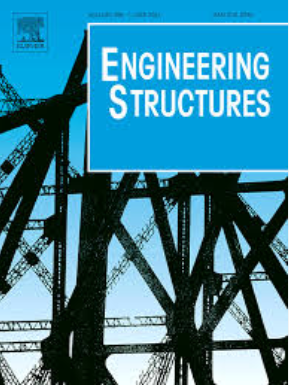使用电磁动态减振器的电气设备减振:振动台试验和数值模拟
IF 6.4
1区 工程技术
Q1 ENGINEERING, CIVIL
引用次数: 0
摘要
为了降低核电站设备的地震振动,提出了一种电磁动态减振器。结合钍熔盐堆(TMSR)模型产生的激励,考虑与土壤和植物结构的相互作用,通过综合设备- emdva系统的振动台试验验证了该方法的有效性。EMDVA集成了具有非线性刚度的线性弹簧和电磁弹簧元件,实现了较宽的控制频率范围,同时降低了对激励幅度变化的灵敏度。通过对电磁弹簧的理论和实验研究,分析了电磁弹簧的阻尼机理。结果表明,EMDVA将振动能量转移到更宽的频率范围并迅速消散,优于电气柜中的线性DVA。增加非线性刚度会拓宽控制带宽,但会降低对激励幅值变化的稳定性。参数分析表明,当初始非线性刚度比例为50-80 %时,EMDVA在最小灵敏度增加的情况下提供了更宽的控制带宽。在强激励下,与DVA相比,EMDVA可以降低最大工作冲程,使其更适合空间受限的设备应用。本文章由计算机程序翻译,如有差异,请以英文原文为准。
Vibration reduction of electric equipment using an electromagnetic dynamic vibration absorber: Shaking table tests and numerical simulations
This study proposes an electromagnetic dynamic vibration absorber (EMDVA) to reduce the seismic vibration of equipment in nuclear power plants. Its effectiveness is validated through shaking table tests of the integrated equipment-EMDVA system, with excitations generated by a thorium molten salt reactor (TMSR) model, considering the interaction with soil and plant structures. The EMDVA, integrating linear springs and electromagnetic spring elements with nonlinear stiffness, achieving a wide control frequency range while reducing sensitivity to variations in excitation amplitude. The damping mechanism is analyzed through theoretical and experimental studies of electromagnetic springs. Results reveal that the EMDVA transfers vibration energy to a wider frequency range and dissipates it quickly, outperforming the linear DVA in electrical cabinets. Increasing nonlinear stiffness broadens the control bandwidth but reduces stability to excitation amplitude variations. Parameter analysis shows that when the initial nonlinear stiffness proportion is 50–80 %, the EMDVA offers a significantly wider control bandwidth with minimal sensitivity increase. Under intense excitations, the EMDVA can decrease the maximum working stroke compared to the DVA, making it more suitable for space-constrained equipment applications.
求助全文
通过发布文献求助,成功后即可免费获取论文全文。
去求助
来源期刊

Engineering Structures
工程技术-工程:土木
CiteScore
10.20
自引率
14.50%
发文量
1385
审稿时长
67 days
期刊介绍:
Engineering Structures provides a forum for a broad blend of scientific and technical papers to reflect the evolving needs of the structural engineering and structural mechanics communities. Particularly welcome are contributions dealing with applications of structural engineering and mechanics principles in all areas of technology. The journal aspires to a broad and integrated coverage of the effects of dynamic loadings and of the modelling techniques whereby the structural response to these loadings may be computed.
The scope of Engineering Structures encompasses, but is not restricted to, the following areas: infrastructure engineering; earthquake engineering; structure-fluid-soil interaction; wind engineering; fire engineering; blast engineering; structural reliability/stability; life assessment/integrity; structural health monitoring; multi-hazard engineering; structural dynamics; optimization; expert systems; experimental modelling; performance-based design; multiscale analysis; value engineering.
Topics of interest include: tall buildings; innovative structures; environmentally responsive structures; bridges; stadiums; commercial and public buildings; transmission towers; television and telecommunication masts; foldable structures; cooling towers; plates and shells; suspension structures; protective structures; smart structures; nuclear reactors; dams; pressure vessels; pipelines; tunnels.
Engineering Structures also publishes review articles, short communications and discussions, book reviews, and a diary on international events related to any aspect of structural engineering.
 求助内容:
求助内容: 应助结果提醒方式:
应助结果提醒方式:


